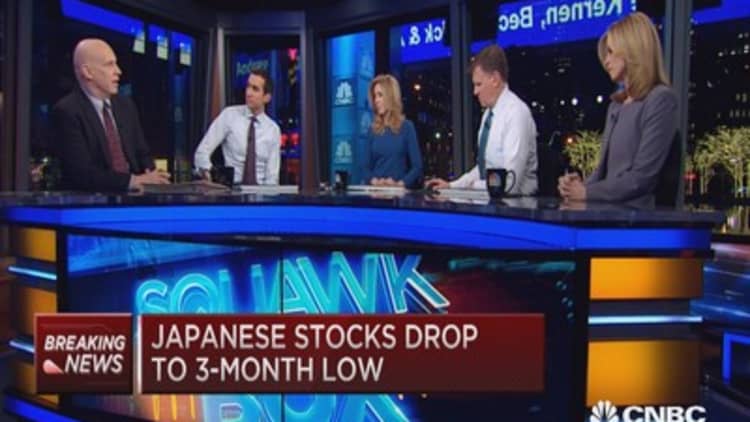Investors were already bracing for a rough fourth quarter from Macy's, after CEO Terry Lundgren warned in November that it would be forced to take markdowns to work through a glut of warm-weather apparel.
But while the overall retail sector is far from posting robust sales growth, stronger-than-expected results from others in the industry demonstrated that many of Macy's issues are specific to the department store, and not signs of widespread frailty.
After Macy's released disappointing holiday sales on Wednesday — lowering its guidance for the second time in two months in the process — figures from competitors including L Brands and Barnes & Noble topped expectations.
At L Brands, same-store sales in December rose 8 percent, easily topping the company's guidance of a low-single digit increase. At J.C. Penney, comparable sales for the November to December period grew 3.9 percent, standing in stark contrast to Macy's 4.7 percent decline.
Revenues at The Children's Place and Signet also topped Wall Street expectations, as specialty shops including Francesca's and Zumiez raised their fourth-quarter earnings guidance.
"Obviously Macy's was very disappointing after the close yesterday, but not unanticipated," said Ken Perkins, president of Retail Metrics. "But most everything else that's come in has been relatively good."
In the company's earnings release, Lundgren blamed 80 percent of Macy's comparable-sales decline to "shortfalls" in cold-weather goods, including coats, sweaters and boots. Though unseasonably warm weather no doubt took a chunk out of retailers' holiday sales — Planalytics estimates specialty apparel stores lost $572 million in November and December because of it — analysts agree that Macy's issues extend well beyond balmy conditions.
Some of those issues are secular in nature. Craig Johnson, president of Customer Growth Partners, said that mall-based retailers are wrangling with mid- to high-single digit traffic declines, as well as competition from low-price competitors such as TJX. Meanwhile, the department store segment doesn't resonate as well with the new generation of consumers, who are shifting their spending away from apparel.
In that vein, Morgan Stanley on Thursday downgraded "best-in-class" department store Nordstrom to "underweight," citing headwinds to department stores' margins.
For Macy's more specifically, other challenges include slowing international economies and a stronger dollar, which dented sales from foreign tourists at its flagship locations including Herald Square. Sales from international tourists typically account for 5 percent of the retailer's annual sales.
"It was almost the perfect storm," Rick Snyder, an analyst at Odeon Capital Group, told CNBC's "Squawk Box."
But it wasn't totally unexpected. According to Retail Metrics data, Macy's quarterly same-store sales consistently outperformed the rest of the retail industry coming out of the recession until the start of 2013. It has now underperformed in each of the last five quarters.
Analysts agreed that Macy's is taking the right steps to fix its problems — namely, entering the off-price space with its new Backstage stores, acquiring the off-mall Bluemercury beauty chain, exploring ways to make money from its real estate, and slashing costs by $400 million through job cuts and store closures.
Those latter two initiatives helped lift Macy's shares more than 3 percent on Thursday, near $37, despite its disappointing holiday results. But Johnson said the problem with many of the retailer's solutions is that they have not yet reached critical mass — and they won't for some time.
He pointed to its Backstage format as an example, which boasts just six stores despite being in the works for more than a year.
"They've been doing some things right," he said. "The problem for them is all of those things are really not that material."

Analysts also contend that Macy's, along with others in the retail sector, could stand to shed more weight from their bloated store counts. Although Macy's detailed plans for its previously announced 40 store closings, Perkins said they need to do more. It currently operates about 900 stores under its various Macy's, Bloomingdale's and Bluemercury nameplates.
The issue, Snyder said, is that it's not always easy to close stores, as lease restraints can sometimes make it more expensive to exit a location than operate at a loss. Still, Perkins said there are likely more store closures from Macy's and its peers to come. He pointed to Finish Line as an example, which said Thursday that it will close a quarter of its stores over the next four years.
Macy's woes come as an even bigger blow because they are happening as mid-tier competitor J.C. Penney continues to gain ground. Hours after Macy's announced its same-store sales fell 4.7 percent in November and December, Penney's countered with a 3.9 percent gain. But while Perkins said it's another positive development for the recovering retailer, he said management should be aiming for more robust gains.
Johnson added that even as Macy's continues to lose share, it's still outperforming Penney's. Whereas Wall Street expects Macy's revenues to come in at roughly $8.86 billion, Penney's sales are forecast to reach less than half that amount, at $3.99 billion, according to Thompson Reuters.
"I still hesitate to put too much emphasis on Penney's given how much business they lost and what they're building back," he said.
That said, Snyder — who has a $32 price target on Macy's — said he would still need to see its shares move lower to buy in.
"I don't think the pain is over," he said.





